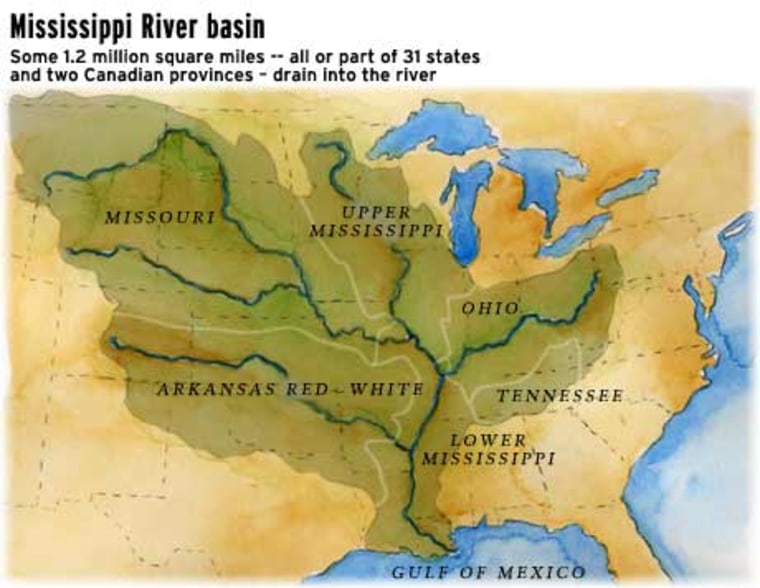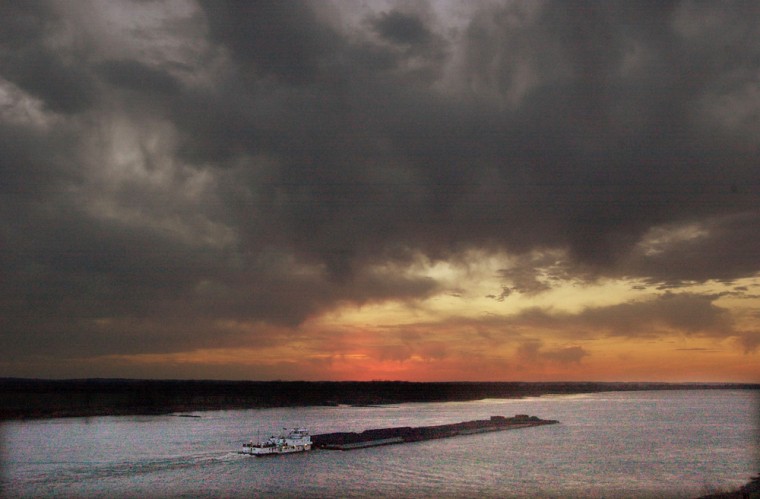From its birth as a brook emerging from northern Minnesota’s Lake Itasca, the Mississippi River meanders at least 2,300 miles to its fire-hose finale at the Gulf of Mexico. Add a few hundred miles for side trips and river crossings and you’ll arrive at the distance that MSNBC.com will cover in the next two weeks as we trace the great waterway’s route through America’s heartland and introduce you to some of the people who live, work and play on the river and its banks.
It promises to be a fun and fascinating trip, as we — and you, vicariously — experience the river’s rhythms, sample the culture, food and entertainment that the Mississippi River Valley is famous for, and meet the sort of river characters that Mark Twain would be writing about if he was still with us.
The news ‘hooks’
But there are even better reasons for making this journey, the kind that capture editors’ interest:
- This is an important time for the river. Congress is preparing to vote on a controversial $7.8 billion plan to fund improvements to its outdated dams and locks and, at the same time, pay for restoration projects aimed at repairing some of the environmental damage to the river caused by decades of use as a commercial superhighway.
- The Mississippi remains a powerful economic engine, generating $284 billion in economic activity annually and supporting 1.6 million jobs. But some business leaders say that the lack of needed navigational improvements and increased global competition are undercutting its pre-eminence as an agricultural and industrial conduit.
- Environmentalists see alarming signs that Old Man River is suffering from hardening of the artery – the result of 70-plus years of building dams, locks and jetties that resulted in serious loss of habitat for the birds that use the valley as a migratory flyway. They also are concerned about pollution in a water source that fills the taps of more than 4 million people but also creates a virtually lifeless “dead zone” larger than the state of Connecticut in the Gulf of Mexico.
- The river flows through key battlegrounds in the November presidential election, with seven of the 10 states that border it – Arkansas, Iowa, Louisiana, Minnesota, Missouri, Tennessee and Wisconsin – considered swing states.
- Anti-terrorism forces face a daunting task in attempting to secure hundreds of miles of waterfront terminals, plants and hazardous materials stores while monitoring the huge volume of traffic that enters and exits the river each day.
The best reason of all for our head-to-mouth river journey, however, is one that has no news “hook” – the Mississippi is a national treasure that, because of its enduring presence, is too often taken for granted.
Most-striking particulars
Virtually every current or former school kid beyond the age of 10 has at least a passing acquaintance with the Mississippi River, but those early lessons aimed at conveying its grandeur and importance in American history tend to fade rather quickly. With that in mind, a quick review of some of the river’s most-striking particulars:
- The Mississippi is the largest river in North America, with its major tributaries draining an area of approximately 1.2 million square miles, including all or part of 31 states and Canada’s provinces of Alberta and Saskatchewan. That is the third-largest drainage on the planet, behind only the Amazon and the Congo basins.
- At its mouth, the river discharges an average of 612,000 cubic feet of water – or nearly 4.6 million gallons – per second into the Gulf of Mexico. That’s enough water to fill a swimming pool 1,228 feet long, 230 feet across and 46 feet deep every second.
- Despite its power, which also is demonstrated through the occasional devastating flood, the river is one of the planet’s most serpentine waterways, twisting and turning as it falls a measly 1,475 feet from its source to the sea. It also has a habit of altering its course whenever it can, which may account for the confusion as to its actual length: The staff at Itasca State Park pegs it at 2,552 miles, the U.S. Geologic Survey checks in at 2,300 miles and the Mississippi National River and Recreation Area maintains it’s 2,350 miles long.

River's rich history
Many Americans – even some of those who live alongside it – also forget that the Mississippi has a history as rich as the loam that makes its valley one of the world’s most-fertile agricultural areas.
Long before President Thomas Jefferson engineered the Louisiana Purchase in 1803, it was the major thoroughfare by which native Americans and early French and British explorers traveled through what was, for the Europeans at least, the western frontier.
After its purchase, the river opened the real West for exploration and demonstrated its strategic importance by being at the center of conflicts in the French and Indian war, the war of 1812 and the Civil War.
With navigation improvements that opened the river to shipping as far north as Minneapolis-St. Paul, the Mississippi also played an important part in the nation’s economic development, giving farmers and manufacturers in the Midwest ready access to foreign markets and providing a competitive transportation route for incoming commodities to reach the region.
It also served as a remarkably efficient means of spreading cuisines and musical and literary ideas north and south, producing innovative sounds, words and tastes that continue to resonate to this day.
The depth of the river’s historic and cultural currents make it a fascinating lab for students of American history and culture, says Douglas Brinkley, director of the Eisenhower Center for American Studies at the University of New Orleans.
A waterway at one with America
“When one studies American history, the Mississippi River is part of all of it, the nation’s culture, military history, industrial history,” he said. “… Where ever you go, in every city, in every village, in every hamlet, there is history of one sort or another.”
Brinkley should know, having traveled the length of the river, south to north, with the late historian Stephen Ambrose in preparing their book “The Mississippi and the Making of a Nation” to commemorate the bicentennial of the Louisiana Purchase in 2003.
Now it’s our turn to fill our beakers with living history and get a sense of the state of the American heartland, though we’ll make our trip from north to south and, rather than collecting material for a book, we’ll be filing stories and multimedia each day.
Along the way, we’ll talk with the men and women who live and work on and along the river, and we’ll explore the culture, the myths, the commerce and the politics as we head by car, canoe, steamboat and barge to the Gulf.
We have some ideas about where we’re headed and who we’ll talk to, but we’re also keeping our options open for the times when we encounter the kind of characters that Twain was talking about when he wrote, “When I find a well-drawn character in fiction or biography I generally take a warm personal interest in him, for the reason that I have known him before — met him on the river.”
Reporter and media producer Jim Seida are travelling the length of the Mississippi in August and will be filing daily dispatches along the way. If you have a question or comment, mail us at mississippi@msnbc.com.
